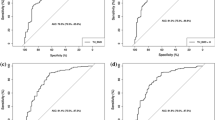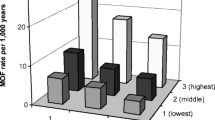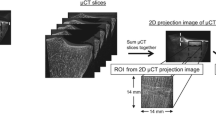Abstract
Summary
We measured bone texture parameters of excised human femurs with a new device (BMA™). We also measured bone mineral density by DXA and investigated the performance of these parameters in the prediction of failure load. Our results suggest that bone texture parameters improve failure load prediction when added to bone mineral density.
Introduction
Bone mineral density (BMD) is a strong determinant of bone strength. However, nearly half of the fractures occur in patients with BMD which does not reach the osteoporotic threshold. In order to assess fracture risk properly, other factors are important to be taken into account such as clinical risk factors as well as macro- and microarchitecture of bone. Bone microarchitecture is usually assessed by high-resolution QCT, but this cannot be applied in routine clinical settings due to irradiation, cost and availability concerns. Texture analysis of bone has shown to be correlated to bone strength.
Methods
We used a new device to get digitized X-rays of 12 excised human femurs in order to measure bone texture parameters in three different regions of interest (ROIs). We investigated the performance of these parameters in the prediction of the failure load using biomechanical tests. Texture parameters measured were the fractal dimension (Hmean), the co-occurrence matrix, and the run length matrix. We also measured bone mineral density by DXA in the same ROIs as well as in standard DXA hip regions.
Results
The Spearman correlation coefficient between BMD and texture parameters measured in the same ROIs ranged from −0.05 (nonsignificant (NS)) to 0.57 (p = 0.003). There was no correlation between Hmean and co-occurrence matrix nor Hmean and run length matrix in the same ROI (r = −0.04 to 0.52, NS). Co-occurrence matrix and run length matrix in the same ROI were highly correlated (r = 0.90 to 0.99, p < 0.0001). Univariate analysis with the failure load revealed significant correlation only with BMD results, not texture parameters. Multiple regression analysis showed that the best predictors of failure load were BMD, Hmean, and run length matrix at the femoral neck, as well as age and sex, with an adjusted r 2 = 0.88. Added to femoral neck BMD, Hmean and run length matrix at the femoral neck (without the effect of age and sex) improved failure load prediction (compared to femoral neck BMD alone) from adjusted r 2 = 0.67 to adjusted r 2 = 0.84.
Conclusion
Our results suggest that bone texture measurement improves failure load prediction when added to BMD.


Similar content being viewed by others
References
Marshall D, Johnell O, Wedel H (1996) Meta-analysis of how well measures of bone mineral density predict occurrence of osteoporotic fractures. BMJ 312:1254–1259
Ott SM, Kilcoyne RF, Chesnut CH (1987) Ability of four different techniques of measuring bone mass to diagnose vertebral fractures in postmenopausal women. J Bone Miner Res 2:201–210
Shuit SC, Van Der Klift M, Weel AE, De Laet CE, Burger H, Seeman E et al (2004) Fracture incidence and association with bone mineral density in elderly men and women: the Rotterdam study. Bone 34:195–202
Faulkner KG, Cummings SR, Black D, Palermo L, Glüer CC, Genant HK (1993) Simple measurement of femoral geometry predicts hip fracture: the study of osteoporotic fractures. J Bone Miner Res 8:1211–1217
Christiansen C (1993) Consensus development conference: diagnosis, prophylaxis and treatment of osteoporosis. Am J Med 94:646–650
Sornay-Rendu E, Boutry S, Munoz F, Delmas PD (2007) Alterations of cortical and trabecular architecture are associated with fractures in postmenopausal women, partially independent of decreased BMD measured by DXA: the OFELY study. J Bone Miner Res 22:425–433
Borggrefe J, Graeff C, Nickelsen TN, Marin F, Gluer CC (2010) Quantitative computed tomographic assessment of the effects of 24 months of teriparatide treatment on 3D femoral neck bone distribution, geometry, and bone strength: results from the EUROFORS study. J Bone Miner Res 25:472–481
Lespessailles E, Chappard C, Bonnet N, Benhamou CL (2006) Imaging techniques for evaluating bone microarchitecture. Joint Bone Spine 73:254–261
Pothuaud L, Carceller P, Hans D (2008) Correlations between grey-level variations in 2D projection images (TBS) and 3D microarchitecture: applications in the study of human trabecular bone microarchitecture. Bone 42:775–787
Winzenrieth R, Dufour R, Pothuaud L, Hans D (2010) A retrospective case–control study assessing the role of trabecular bone score in postmenopausal Caucasian women with osteopenia: analyzing the odds of vertebral fracture. Calcif Tissue Int 86:104–109
Lespessailles E, Jacquet G, Harba R, Jennane R, Loussot T, Viala JF, Benhamou CL (1996) Anisotropy measurements obtained by fractal analysis of trabnecular bone at the calcaneus and radius. Rev Rhum Engl Ed 63:337–343
Pothuaud L, Lespessailles E, Harba R, Jennane R, Royant V, Eynard E, Benhamou CL (1998) Fractal analysis of trabecular bone texture on radiographs: discriminant value in postmenopausal osteoporosis. Osteoporos Int 8:618–625
Vokes TJ, Giger ML, Chinander MR, Karrison TG, Favus MJ, Dixon LB (2006) Radiographic texture analysis of densitometric-generated calcaneus images differentiates postmenopausal women with and without fractures. Osteoporos Int 17:1472–1482
Lespessailles E, Jullien A, Eynard E, Harba R, Jacquet G, Ildefonse JP, Ohley W, Benhamou CL (1998) Biomechanical properties of human os calcanei: relationships with bone density and fractal evaluation of bone microarchitecture. J Biomech 31:817–824
Heini PF, Franz T, Fankhauser C, Gasser B, Ganz R (2004) Femoroplasty-augmentation of mechanical properties in the osteoporotic proximal femur: a biomechanical investigation of PMMA reinforcement in cadaver bones. Clin Biomech 19:506–516
Beckmann J, Ferguson SJ, Gebauer M, Luering C, Gasser B, Heini P (2007) Femoroplasty-augmentation of the proximal femur with a composite bone cement—feasibility, biomechanical properties and osteosynthesis potential. Med Eng Phys 29:755–764
Van der Steenhoven TJ, Schaasberg W, de Vries AC, Valstar ER, Nelissen RGHH (2009) Augmentation with silicone stabilizes proximal femur fractures: an in vitro biomechanical study. Clin Biomech 24:286–290
Kyle RF, Gustilo RB, Premer RF (1979) Analysis of six hundred and twenty-two intertrochanteric hip fractures. J Bone Joint Surg 61:216–221
Cody DD, Gross GJ, Hou FJ, Spencer HJ, Goldstein SA, Fyhrie DP (1999) Femoral strength is better predicted by finite element models than QCT and DXA. J Biomech 32:1013–1020
Lochmuller EM, Zeller JB, Kaiser D et al (1999) Correlation of femoral and lumbar DXA and calcaneal ultrasound, measured in situ with intact soft tissues, with the in vitro failure loads of the proximal femur. Osteoporos Int 1998(8):591–598
Kukla C, Gaebler C, Pichl RW, Prokesch R, Heinze G, Heinz T (2002) Predictive geometric factors in a standardized model of femoral neck fracture. Experimental study of cadaveric human femurs. Injury 33:427–433
Le Bras A, Kolta S, Soubrane P, Skalli W, Roux C, Mitton D (2006) Assessment of femoral neck strength by 3-dimensional x-ray absorptiometry. J Clin Densitom 9:425–430
Caligiuri P, Giger ML, Favus Mj, Jia H, Doi K, Dixon LB (1993) Computerized radiographic analysis of osteoporosis: preliminary evaluation. Radiology 186:471–474
Gregory JS, Stewart A, Undrill PE, Reid DM, Aspden RM (2004) Identification of hip fracture patients from radiographs using Fourier analysis of the trabecular structure: a cross-sectional study. BMC Med Imaging 4:4
Benhamou CL, Poupon S, Lespessailles E, Loiseau S, Jennane R, Siroux V et al (2001) Fractal analysis of radiographic trabecular bone texture and bone mineral density: two complementary parameters related to osteoporotic fractures. J Bone Miner Res 16:697–704
Lespessailles E, Gadois C, Kousignian I, Neveu JP, Fardellone P, Kolta S, Roux C, Do-Huu JP, Benhamou CL (2008) Clinical interest of bone texture analysis in osteoporosis: a case control multicenter study. Osteoporos Int 19:1019–1028
Vokes T, Lauderdale D, Ma SL, Chinander M, Childs K, Giger M (2010) Radiographic texture analysis of densitometric calcaneal images: relationship to clinical characteristics and to bone fragility. J Bone Miner Res 25:56–63
Cohen A, Dempster DW, Müller R, Guo XE, Nickolas TL, Liu XS et al (2010) Assessment of trabecular and cortical architecture and mechanical competence of bone by high-resolution peripheral computed tomography: comparison with transiliac bone biopsy. Osteoporos Int 21:263–273
Lespessailles E, Roux JP, Benhamou CL, Arlot ME, Eynard E, Harba R et al (1998) Fractal analysis of bone texture on os calcis radiographs compared with trabecular microarchitecture analyzed by histomorphometry. Calcif Tissue Int 63:121–125
Bacchetta J, Boutry S, Vilayphiou N, Fouque-Aubert A, Delmas PD, Lespessailles E et al (2010) Assessment of bone microarchitecture in chronic kidney disease: a comparison of 2D bone texture analysis and high-resolution peripheral quantitative computed tomography at the radius and tibia. Calcif Tissue Int 87(1):385–391
Pothuaud L, Benhamou CL, Porion P, Lespessailles E, Harba R, Levitz P (2000) Fractal dimension of trabecular bone projection texture is related to three-dimensional microarchitecture. J Bone Miner Res 15:691–699
Huber MB, Caballido-Gamio J, Fritscher K, Schubert R, Haenni M, Hengg C et al (2009) Development and testing of texture discriminators for the analysis of trabecular bone in proximal femur radiographs. Med Phys 36:5089–5098
Chappard C, Bousson V, Bergot C, Mitton D, Marchadier A, Moser T et al (2010) Prediction of femoral fracture load: cross-sectional study of texture analysis and geometric measurements on plain radiographs versus bone mineral density. Radiology 255:536–543
Benhamou CL, Lespessailles E, Jacquet G, Harba R, Jennane R, Loussot T et al (1994) Fractal organization of trabecular bone images on calcaneus radiographs. J Bone Miner Res 9:1909–1918
Chappard D, Pascaretti-Grizon F, Gallois Y, Mercier P, Baslé MF, Audran M (2006) Medullar fat influences texture analysis of trabecular microarchitecture on X-ray radiographs. Eur J Radiol 58:404–410
Lespessailes E, Gadois C, Lemineur G, Do-Huu JP, Benhamou L (2007) Bone texture analysis on direct digital radiographic images: precision study and relationship with bone mineral density at the os calcis. Calcif Tissue Int 80:97–102
Conflicts of interest
None.
Author information
Authors and Affiliations
Corresponding author
Rights and permissions
About this article
Cite this article
Kolta, S., Paratte, S., Amphoux, T. et al. Bone texture analysis of human femurs using a new device (BMA™) improves failure load prediction. Osteoporos Int 23, 1311–1316 (2012). https://doi.org/10.1007/s00198-011-1674-2
Received:
Accepted:
Published:
Issue Date:
DOI: https://doi.org/10.1007/s00198-011-1674-2




